Entries Tagged as 'Uncategorized'
I had the chance to spend a weekend interviewing international students at Cambridge University because I have a friend from Argentina that is doing a masters program there. I attended an Erasmus dinner and an Indian student gathering at an Indian restaurant.
It was great that I had just finished reading Indian Students in Britain (1963) by Dr. A.K. Singh. The author explains that it was only in the last third of the nineteenth centry that modernising Indians began to look overseas for university studies. Before then, “Oxford and Cambridge were so poor that they did not appeal to the liberal, humane minds of the great Indian and birtish-Indian reformeres of the first half of the century”. It was only after the opening of its examinations to Indian cadidates for the Indian Civil Service in the 1870s that Indignas began in large numers to go overseas for advanced studies. At the time, it was “the thing” for the Indian elite, even if Indian already had three universities of its own and a number of colleges. The students were sons of wealthy and distinguished princes, lawyers, landowneres, and sometimes proteges of Maharajahs. After completing their studies, many of them went back and got very much involved with leftist Indian nationalism.
This is not a new phenomenon and not only applies to India.Many of those famous leaders of independence in the process of decolonization had attended Oxbridge and Ivy League institutions in America. In India, those who were ‘England-returned’ possesed the status-symbol number one in society.
Two things made these interviews important. First, to verify that in fact, the meaning of being educated in the West has not changed for Indian students. Most of them expressed how, even with very good universities back home, the value of an English or American degree is still symbolically higher. Second, it was particularly interesting to see Indian students that attend Cambridge at an Indian restaurant because it made me think of the interaction between the local Indian community that has been born here and these students. I suppose that in England there are many instances that give room for interaction between a local community that interacts with people from their nation of origin such as the Indian community with Indian tourists. Contrary to what I would think, after observing the way the restaurant staff treated the students, it didn’t seem like it matter that they were Indian, but would treat them the same as many other clearly non-Indian customers in the restaurant. However, these third year students had been friends since the first year at Cambridge and they themselves explained that they became a group because they were all Indians. Perhaps it is the caste system, or in England, class, that puts these two groups in such a distance. Perhaps this is an isolated case and in other universities the Indian students have a good relationship with the staff at the local Indian restaurant. i guess further research would be needed.
Other than these observations, I also got very interesting insights to what it is like being a student at Cambridge and the impressions of ‘Englishness’ that these students have, as you will see in the final research.
Hours: 6
Tags: Azul · Uncategorized
February 23rd, 2010 · 1 Comment
“Head down, as I watch my feet take turns hitting the ground”……. The Instructor tells me to look in his eyes, never at the ground, because you never know when your opponent can strike. As a Capoeirista you owe it to yourself, the instructor, your opponent, the Bid-im-bow, and the Rhoda to focus and properly carryout the culture of Capoeira. My first day of Capoeira was about 5 months ago, but I still remember that class as if it was yesterday. I walked into class really not knowing what to expect, other than a few sightings and Venice beach and playing the game Tekken, with Eddy Guardo being one of my favorite characters, I really wasn’t sure what Capoeira was.
The only reason why I entered the class in the first place was because a few days before, I was informed about the signing up for Societies in the LCR. Apart from ACS (Afro-Caribbean Society) nothing really caught my interest, until a student jumped out in front of my face and said, “Ever try Capoeira.” Instantly my mind took me back about a good 12 years when I was at the beach with my family. I was running around in the sand, burying one of my Spiderman toys when I heard faint drumming in the distance. Normally I equated the sounds of drums to West African dance because I had been trained in it since the age of four. But as my feet coerced themselves into the sand the noise became louder. Once I arrived at the sound I discovered a circle of people looking like they were “break dance fighting.” I immediately became intrigued, flares, kicks, and a rhythmic swaying contributed to this foreign sight where the music and the body served as the inspiration for the movement. Once I returned back to my reality I put my name on the list immediately.
Walking into that class that day took me all the way back to when I was 8 because I was going in with the exact same curiosity. We began class by running around and getting our cardio up. We warmed up each of our muscles carefully and attentively as to not betray our bodies because in the latter part of class we would get more physical. As we went through the warm up I realized that Capoeira was going to feel very familiar to me, because as a dancer I was used to moving my body with the sound of music, I would just need to learn this new style and adapt to the movement and music as best as I could.
The instructor gave us the basic movement a swaying motion back and forth switching you weight from right to left, this movement is called “GInga.” The Ginga is the most fundamental part of Capoeira because it provides you the basic fundamental movement that you need in order to play Capoeira. The second major purpose of the Ginga is that it determines your own style, and no one persons Ginga is the same as another’s and once you have acquired your own Ginga you can begin to further explore the culture of Capoeira. Of all the classes I have taken the first one was my favorite because it seemed like second nature, and the instructor really challenged me to push through and not be inhibited by those more advanced than myself.
In the last portion of class the instructor gathered us all up in order to form a “Rhoda” (the circle in which Capoeira takes place. He named the various instruments used in the “Rhoda” some familiar some foreign and discussed the importance of the songs and the role they play in Copoiera. Once we learned a few hymns two people bent down, faced each other in the Rhoda, cart wheeled in and my curiosity began to take me on my journey. I was infatuated with the whole culture of Capoeira, and as the music and body became one, a new vocabulary of movement was opened up to me that I had not yet known existed.
Tags: Anthony · Uncategorized
September 15th, 2009 · 1 Comment
After visiting all of the royal parks in London, I can only think of how different they look to the common parks, or “the commons”. After visiting Clapham Common Park, I found out about its history. The commons were the old medieval forests, the only places that were allowed for the peasants when everything belonged to the feudalist lord. Many of the commons today are those that remained from that time, but that are now public. Clapham Common Park does not look at all like Regent’s park or Hyde Park or any of the Royal parks. It does not have as many or any flowers, it is not as clean, and does not have any fountains or sculptures.
Something that I did notice however that any London park presents is diversity. I observed the children play at a park in Golder’s Green, among them in the playground was my little cousin, son of an Argentinean mother and a North Londoner. Never in my life have I seen so many children from different ethnicities playing together. We have been talking about integration, and I could not help but think that if there is anything that integration means is the image of so many children of different color, religion and class (who at the same time have mothers that are different between each other and with husbands that are different to their wives. I saw so many mixed marriages, specially Indian men with white women and white men with Chinese women. I know so because I as bold enough to ask them!) playing in the park. If a girl was wearing a head scarf, that did not stop her to say “catch me if you can!” to a boy wearing a yarmulke. Of course, we would have to see what happens to these children when they grow up…
Tags: Uncategorized
September 15th, 2009 · No Comments
Although I think pubs are great because they are just fun places to be at and to socialize, I cannot help but thinking of Buenos Aires, Paris or Madrid, or anywhere in Italy, or in so many other countries, where people do not need alcohol to unwind after a day at the office.
Pubs in London start getting crowded since five in the afternoon. People stay for hours and hours. However, in other countries, people can stay for hours in cafes. I think that “happy hour” is more traditional here in England than anywhere else.
I guess every pub or bar in London is charming, but if I had to choose an area, it would be Soho, just because it is more reminiscent of the other European cities that I mentioned, with people having coffee while sitting in small tables on the street, whether it is day or night.
Tags: Uncategorized
September 14th, 2009 · 2 Comments
I had the chance to attend the Feminist Literature tour in which I not only learned about women writers who resided in the Bloomsbury area, but also on how spaces affect who we are and everything that we do. I am intrigued with this notion. Recently I posted a blog on space, specifically focused on sacred/holy spaces, in this blog I will look back and focus on a few others others.

Green Green GREEN
Spaces of recreation, golden flowers and perfectly trimmed grass is what I think of. It is impressive to me how well kept they are. When we visited Regent’s Park during class for the first time, I was at a loss of words, for I had never in my life seen a space so beautiful. William Blake captures this beauty in his poem titled “The Lily:”
The modest Rose puts forth a thorn,
The humble sheep a threat’ning horn:
While the Lily white shall in love delight,
Nor a thorn nor a threat stain her beauty bright.
Regent’s Park could not be touched, human hands could never be gently enough to handle a flower’s delicate body. So untouchable, the flowers arranged almost to perfection. Ralph Waldo Emmerson once said that “Earth laughs in flowers,” and I believe him.
Hyde Park, almost as magical, but words cannot capture the immensity of this park. The amount of green that surrounds you at any given moment is difficult to describe. This park in particular serves as more than just a space for recreation, it is also a place where history is preserved, where various neighborhoods unite and where kids grow up to later bring their own kids to play at Kensington Gardens or near the lake. Green Park, a sort of gateway to Buckingham Palace (if you get off at the Green Park Tube station), can never be compared to Hyde Park for it lacks in immensity. Even though the deck chairs are a nice touch to the park, the area I visited lacked some color (as in floral color); I was not impressed. (Buckingham Palace itself was not very impressive. I was surprise to discover that it actually isn’t an enormous, glorious and royal-looking mansion… I guess it’s a good thing that it isn’t after all!)
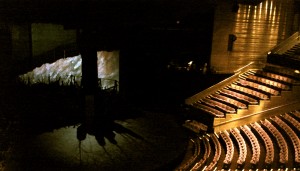
Let’s start the show!!!
Sometimes walking in for the first time takes my breath away, and sometimes the shows blows my mind, other times the idea of sitting there makes me wonder… wow. The three different halls of at the National Theatre, The Globe, Duke of York’s, the Phoenix and last but not least Royal Albert Hall! So here’s the list: “Troilus and Cressida,” “Arcadia,” “All’s Well That Ends Well,” “As You Like It,” “Pitmen Painters” and the not-so awesome musical “Blood Brothers,” oh and the amazing violin concerto at the Royal Albert. In London, I am never too far from New York City’s Broadway experience! The difference, the London experience always feels fulfilling no matter how horrible the play was. This is probably because Broadway shows are not exactly affordable, and while the National Theatre insists on having a wide range of prices (so that everyone can enjoy the theatre), Broadway just seeks revenue and to maintain it’s current status and popularity. I mean, to have Rick Fisher (who by the way is a Dickinson alum), winner of of a Tonny award, come to speak to us about his thoughts and experiences with London’s theatre scene, that within itself was enough to top all of the Broadway shows I have seen in my life! I <3 the London theatre experience!
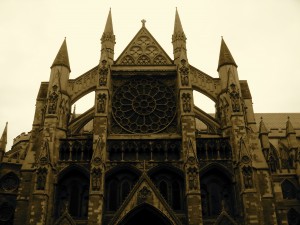
Religious spaces.
Intricate architecture, imagination, creativity and grace is what comes to mind when I think of churches. I’ve written a blog about them but I wanted to look back at a few of them. Westminster, ridiculously sacred, marvelous, immense and glorious. The same can be said about St. Paul’s Cathedral and the Hindu Temple we visited. At Brixton (where I directed a tour along with my teammates), I learned that religious spaces play a huge role in the community, one that extends beyond any religious affiliations. One specific church we visited during our research, Corpus Christi Roman Catholic church was involved in the reconstruction of the Brixton area after the Brixton riots, when parts of the neighborhood where damaged/destroyed due to violent protests. It always brings joy to my heart when people come together to help each other, regardless of any religious/cultural boundaries.

Clubs NOT Pubs
Ooooh pubs…. I’ve heard that you can see London’s history evolve in these spaces, and although they are known as spaces of leisure and social interaction their walls can tell unknown stories of both know and unknown visitors. I am always intrigued by pubs, so intrigued I am intimidated by them. I now that sounds a little ridiculous but in pubs I feel pressured to consume alcohol (after all that is the main purpose of a pub: to provide alcoholic beverages) and to maintain conversation when really all I want to do is dance to the awesome music playing in the background. Rebbeca (who along with 4 others constructed a tour of London’s historic pubs) has attempted to both enlighten me as well as persuade me to engage in pub culture, but I have yet to fully explore the wonderful world of London’s historic pubs.
Clubs, on the other hand, I’ve also had a difficult time with. I’ve realized that there isn’t much dancing that goes on, but rather an attempt to dance, which actually means jumping around to Lady Gaga’s “Just Dance” (pop/techno song). Over all, I have enjoyed late hip hop nights at Metra (dance club a few street corners off the Leichester Square tube stop) only because I have shared that space with amazing people who can turn any floor into a dance floor. (Thanks Anthony, Jeyla and Patsy!)

Spaces, our everyday living takes place within them, whether they are churches, clubs, parks or theaters. We lack to realize their importance, we never stop to think of how a room may affect how we feel about ourselves and about the rest of society. A room can change our lives, like the reading room at the British Museum that the feminist writers group spoke of on their tour. This room clearly changed Virginia’s Wolf literature, among other authors, I’m sure.
Note to self: Whether this room is physical or mental, it is important. We must take more time to appreciate a rooms ability to change the way we exist in our own individual worlds.
The End.
Tags: Flow · Uncategorized
September 11th, 2009 · 3 Comments
In the play Pitmen Painters, two of the most profound lines, for me, were “stop being scared of the world” and “the mystery of being alive”. Now as a I reflect on the play as a whole, I’m unable to remember the context in which they were said however, for some reason they have remained in my thoughts through out this entire day.
yesterday in a nutshell
– wake up
– breakfast
-gym
– lunch
– The Globe Theater
– cook dinner (burn chicken)
– email banter, fight, crap
– Pitmen Painters
– watch this space rehearsal
today in a nutshell
-wake up
– research
– lunch
– walking tour
– research
I compared these past two days, and all I can think about was, when we first arrived in London. We spent every day exploring. We stumbled upon museums, buildings, and cafes all of which seemed to be waiting for us. Now, are we allowed to say we are familiar with the city, and just stop?
Why are we here? How will this experience benefit our lives? What will we take from living in this strange city? What is the purpose?
After I saw the play Pitmen Painters, I was undoubtedly blown away by the creative and emotional connection I experienced, through the performers. Not only did I enjoy the acting and the humor, but I felt the message was incredible. Past the drama, and past the humor, I felt as though their was a consistent theme of self-improvement. I thought it was beautiful how they depicted the closed and simple life of a miner, and how easily a life can be influenced with simple encouragement. These men lived a hard and terrible life, but because of the sharing of knowledge, they were able to observe creativity, and let it improve their mental state of being.
These men stopped being afraid of the world. Do I have the ability to do this? I want to, but can I? Do you need to live in a time of oppression or discomfort in order to realize your due for self improvement?
Tags: Patsy · Uncategorized
September 11th, 2009 · No Comments
This past Monday I had the opportunity to go horseback riding in Hyde Park. And honestly, this experience was a lifesaver to me. Back home I hardly go three days without at least spending some time in a barn or riding my horse. Those hours spent on and around the horses are a source of stress relief. So these past weeks here without opportunities to go riding or spend an hour or two in a barn, have been hard. It’s caused me to find new ways to relieve stress. Museums are new form of stress relief as well as aimless walks through the parks of London. Yet, when Monday came around and I found myself with the chance to go riding, I was ecstatic. It was an amazing feeling being back on horse, even if it was only for an hour. This ride though, was even more special than I expected it to be. It was actually a learning experience about the park and riding in England.
In respect to the ride as a learning experience, it provided a new way to look at the park for me. I had been in Hyde Park numerous times before that doing research for my walking tour. But Hyde Park from the back of horse is completely different and as such it was eye opening. From the back of a horse, Hyde Park becomes completely removed from the city. Even walking by the road while riding, it felt as though I was in the middle of woodland and not London. For me, it felt as though I had the opportunity to experience Hyde Park as it was meant to be experienced by earlier generations. It was a way to return to the past of Hyde Park. This feeling helped me better understand the origins of Hyde Park and it even helped me with understanding my research on the early history of the park. Moreover, this experience was also a chance to experience riding in another country. I have been riding for over ten years and therefore am pretty knowledgeable about riding in the States. Also, I have had opportunities to train with English trainers, but had never ridden outside of the country before. I was not expecting there to be many differences since I had ridden in the English style, which is obviously the style used here. Yet again though, I was surprised by this country. There is a difference in the vocabulary used in respect to both riding style, riding equipment and even with the horse. It was humbling in one way. It showed me that I can always learn, even if it is something that I feel very confident in concerning my knowledge and experience. Even though, it was humbling and different the fact that I could connect with another rider from England through our shared love of riding was an amazing experience. It proved to me that it doesn’t matter what your culture is, if you share a love for something it helps you overcome different vocabularies and viewpoints.
I feel that this is the one experience that will stay with me the longest from London. Firstly due to my great love for horses and riding, but also because it was the first moment that I truly connected with a Londoner over something we both loved. It was a moment that I shared with a fellow rider, without considering our different nationalities. It was something more than exploring the city with fellow Americans and that made it a very unique moment of connection.
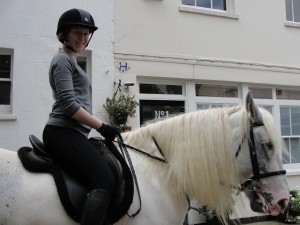
Tags: Kimberly · Uncategorized
September 11th, 2009 · No Comments
Pitmen Painters proved not only to be an enjoyable play, but another opportunity to enjoy Watch this Space at the National Theatre. From previous experiences at Watch This Space, I had come to expect music, dance and acting from the performances I had seen. Last night though, it was a complete surprise what they had performing in the green area. This weekend’s performance is La Roué de la Mort: La Trilogie du Temps. As the website states, “For Thames Festival weekend, we have one of the most jaw-dropping spectacles we’ve ever seen. On a remarkable structure of a counterweighted cylindrical wheel which pivots around a 10m wide central axis, a trilogy of narratives weave a dramatic episodic spectacle through time.” It is a three part presentation on time and how it can affect humanity. How it’s presented is through amazing acrobatics and gymnastics. When we exited the theatre we found ourselves gaping at this large spinning wheel. We actually described as an overly large, unusually constructed hamster wheel. As to what it would be used for, we had no idea. Then we understood as the performers came up to the wheel and began spinning it and doing crazy gymnastics on and through it. We were all amazed to the point of being incapable of speech. It wasn’t something we would expect from an area sponsored by the National Theatre.
To me, it was another example of how the performing arts here receive more support from the state. And I find myself jealous of the opportunities that it provides for British citizens. They have the ability to find free performances of groups that we would have to pay dearly for back home. This is the one aspect of London and Britain as an entity that I have come to admire and even envy. Even though, I do not participate in the arts anymore, it is still something I love. There is nothing better than seeing a good play, concert, opera, et cetera. But back home, it costs money to enjoy this. Here, there are numerous opportunities for free concerts, plays, and other types of performing arts. Not only are they free, but they are guaranteed to happen. They aren’t scheduled and then canceled due to a lack of interest. There is an interest here for them. That is something that I envy. It also speaks wonderfully of how the British view and support the arts. They don’t limit performances to only music or drama, but include other forms such as the one being featured this weekend or the one for next weekend, which is called “Spin Cycle” and includes the washing of dirty linen and bicycle dances. I can honestly say that Watch This Space and London’s appreciation of the performing arts is the one aspect I will miss the most when we leave for Norwich.
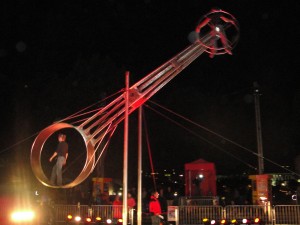
Tags: Kimberly · Uncategorized
September 8th, 2009 · 1 Comment
My high school was a very small all girls, Catholic, private school in the outskirts of Boston. When most people hear this they imagine a few things: uniforms (which we didn’t have), nuns roaming around the halls (which we didn’t have), and very strict Catholic religion classes (which we also didn’t have). It is the last of those things that I am most proud of, at my school I was fortunate to study all different religions during my time and my senior year I was exposed briefly to Buddhism, Islam, and Hinduism. This being said, I had previously visited a Hindu temple and experienced the lives of those Hindus living and adapting to life in Central Massachusetts. I assumed that my visits to the Hindu temple and the Sikh gurdwara would be easy, peaceful, and educational as other locations that I had visited, however I was surprised when both of these visits took a different turn for me.
We visited the Sikh gurdwara first, before our journey I investigated the BBC religion site to learn some of the basics of the Sikh religion. Learning that Sikhism was a practice where its worshipers were completely and totally devote to one God. They believe everyone is equal to one God, and dedication to ones community is of the utmost importance. The man who took us around the temple was just a local from the community rather than a trained tour guide. For me this was a valuable experience because instead of just learning about Sikhism from a book we were getting an inside perspective of the religion. His opinions, feelings, fears, and love of this one belief. He discussed his community, and the special place the Sikh temple holds in the community. They were very open and receptive to us coming in and appreciated our interest. There aren’t many Sikh gurdwaras outside of India, and so making a place outside of India will take some time, and open minds.
Going to the Hindu temple I expected a similar experience to visiting the Sikh gurdwara or the Hindu temple I visited three years ago in Massachusetts, however I was shocked by what I saw instead. Walking through the London neighborhood not knowing exaclty what to expect I almost stopped short when I saw the enormous temple rising above eyesight. We put our bags in security, walked through a metal detector, and then met up with an official temple tour guide. There were so many people in the area, old and young, Hindus and visitors– it was a strange discovery. And then walking around and listening to the guide talk about all of the large Hindu temples around the world and seeing all of the famous visitors I realized that Hinduism is really beginning to be a major player in worldwide religions, especially in London. I felt that the Hindu temple I visited before was in a place where they were struggling to find their place. I did not feel like it was as much as an issue here. I don’t mean to sound cynical, but with so much funding and exposure to me this community is widely accepted in London society. Some may argue with me, that the Sikh temple we visited also received large sums of money, but from my own personal eye I felt that this community was not as acclimated to society as the Hindus.
Both are religions that initially came from India. Sikhism is more surrounded around communal prayer, and Hinduism around individual prayer. Although similar , they are also very different, and I think these differences may play a factor in how they fit in with London society. Both religions came to London relatively around the same time, Hinduism may have more followers which is why I feel it fits in with society better, but I don’t think I’ll ever truly know. I’m also fairly certain my opinion on this matter could change from day to day as I am exposed more to these two religions, but this is what I thinking/feeling now after much contemplation and a little research on the BBC website.
Tags: Amanda · Uncategorized
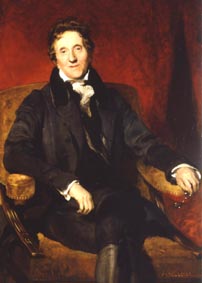
Sir John Soane, R.A.
Yesterday afternoon we decided to walk to the Sir John Soane Museum rather than taking the tube. It was only a few blocks past the British Museum and I was able to see more of the Bloomsbury neighborhood. When we arrived at Lincoln’s Inn Fields, it was easy to spot. First of all, there was a queue of people outside the gates and second, who else would have caryatids on the façade of their house but a classics-loving architect? While I appreciated the concept of the museum, (Sir John wanted to leave his home as a showcase for his antiquities and works of art) I thought it was SO crowded with his artifacts that I could barely focus on the actual architecture of the house. It was like walking into an “Antiques Roadshow” dream house. Ironically, my two favorite rooms were the ones that contained the least amount of classical antiquities, the library and the upstairs sitting room. I loved looking through his books and his paintings (the Turner on the second floor is exquisite!) because I felt that was a better way to try and gage what kind of man Sir John was. You can tell a lot about a person by what he/she reads. I loved the yellow sitting room because it was whimsical and light in the midst of all the dark wood and ancient Greek artifacts. The stained glass and the bright saffron-colored walls provided a nice contrast against the rest of the museum/house. I imagine that Sir John’s wife had a hand in decorating this area (although I can’t be sure) and he left it this way after she passed away. I only wish that there had been some sort of guide that I could have used to navigate through the house or a curator I could have talked to. Obviously, Sir John loved classical sculpture and architecture, and his collection is truly impressive, but I would have liked to see more of the floor plan. Also, I wonder what Soane’s sons could have done to persuade him to even turn the home into a museum. On the homepage all it says is he was “deeply disappointed by the conduct of his two sons.” Any thoughts on that? I really enjoy exploring the places where people lived. It’s fascinating to me… What were they like? What was their daily schedule? What room did they spend the most time in? To any future visitors, make sure you venture down into the basement aka “the crypt” to check out the sarcophagus of Pharaoh Seti I. This is definitely a non-conventional museum. To be perfectly honest, what it lacked in curatorial flair, it made up for in dedication to preservation. The Sir John Soane museum was a welcome change from the halls of slick marble and crowds of tourists that have been a staple of the larger institutions. Sometimes it’s the places off the beaten track that make the biggest impression. While this museum was not my favorite attraction of London, It does showcase the importance of exploring the smaller, less popular areas. Next stop—Chancery Lane!
Tags: Grace · Museums · Uncategorized







